The City of Bath
October 26, 2010
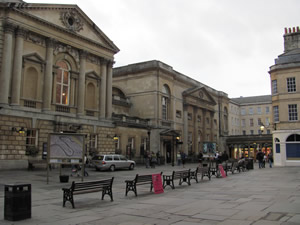 We arrived in Bath at rush hour on a late Friday afternoon – not exactly an auspicious introduction to this beautiful city set among the rolling green hills of the Avon valley. For those who journey there in the future, I recommend leaving the car behind. The streets were difficult to navigate and parking troublesome to find. We made the justifiable mistake of asking the receptionist at our hotel for directions to a nearby parking lot, which resulted in us driving around in circles for fifteen minutes. By the time we made it to our hotel, we were frazzled, tired, and hungry, and we had no time to grab dinner if we were going to make it to the Pump Room to meet up with the free evening city walking tour provided by The Mayor’s Corps of Honorary Guides. After rushing to meet it, we had the misfortune of discovering that the value and enjoyment of the tour depends solely on your guide for the evening, and, though nice, our guide was a rambler and not very informative. I can’t complain—after all, the tour was free—but we decided that we would have preferred to roam the city by ourselves. I had read enough guidebooks to be able to supply the same information to my husband as the tour provided. We arrived in Bath at rush hour on a late Friday afternoon – not exactly an auspicious introduction to this beautiful city set among the rolling green hills of the Avon valley. For those who journey there in the future, I recommend leaving the car behind. The streets were difficult to navigate and parking troublesome to find. We made the justifiable mistake of asking the receptionist at our hotel for directions to a nearby parking lot, which resulted in us driving around in circles for fifteen minutes. By the time we made it to our hotel, we were frazzled, tired, and hungry, and we had no time to grab dinner if we were going to make it to the Pump Room to meet up with the free evening city walking tour provided by The Mayor’s Corps of Honorary Guides. After rushing to meet it, we had the misfortune of discovering that the value and enjoyment of the tour depends solely on your guide for the evening, and, though nice, our guide was a rambler and not very informative. I can’t complain—after all, the tour was free—but we decided that we would have preferred to roam the city by ourselves. I had read enough guidebooks to be able to supply the same information to my husband as the tour provided.
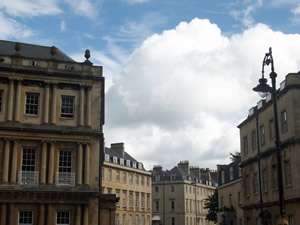 The next morning dawned bright and beautiful and we quickly recovered our spirits, stopping at many notable sights around the city. Bath’s buildings are constructed from elegant, honey-colored Bath stone, which sparkles in the sunlight. Many of its structures were erected during its Georgian heyday, when the wealthy and elite came to take the waters as a curative for numerous ailments, and to gossip and hobnob with each other. Anyone who is a fan of Jane Austen is familiar with the city, for Bath was utilized as a setting in more than one of her novels, and Miss Austen herself lived here at one time. The next morning dawned bright and beautiful and we quickly recovered our spirits, stopping at many notable sights around the city. Bath’s buildings are constructed from elegant, honey-colored Bath stone, which sparkles in the sunlight. Many of its structures were erected during its Georgian heyday, when the wealthy and elite came to take the waters as a curative for numerous ailments, and to gossip and hobnob with each other. Anyone who is a fan of Jane Austen is familiar with the city, for Bath was utilized as a setting in more than one of her novels, and Miss Austen herself lived here at one time.
Bath’s streets are lined with interesting shops and boutiques, making it a veritable Mecca for serious shop-a-nistas. And it has a surprisingly lively nightlife. My husband and I were woken up by a rowdy rendition of a folk tune sung by a group of drunken men making their way home in the wee hours of the morning. Interestingly, we found the experience more amusing than annoying, but perhaps that was the indolent feel of Bath’s charm working its spell on us.
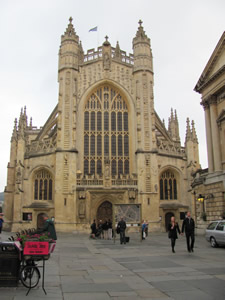 Our first stop on the day we spent in Bath was to the Bath Abbey. Even though Bath wasn’t much of a town in the Middle Ages, an important church has stood on the spot of the abbey’s foundations since Anglo-Saxon times. King Edgar I was crowned there in 973. A window to the left of the altar commemorates this event. Our first stop on the day we spent in Bath was to the Bath Abbey. Even though Bath wasn’t much of a town in the Middle Ages, an important church has stood on the spot of the abbey’s foundations since Anglo-Saxon times. King Edgar I was crowned there in 973. A window to the left of the altar commemorates this event.
The abbey that stands today was supposedly designed by divine intervention, in the form of a dream where God dictated the form of the church to Bishop Oliver King. The eccentric carvings on the west front immortalize this tale. Construction began in 1499, erecting the last great medieval church of England in a fine example of Late Perpendicular Gothic, with breezy fan vaulting and enough stained glass to earn it the nickname “Lantern of the West.” The great window behind the altar shows 52 scenes from the life of Christ. The statue of Peter, to the left of the west door, was beheaded by Parliamentary troops, so his head had to be re-sculpted from the stone at his neck that was once his over-large beard.
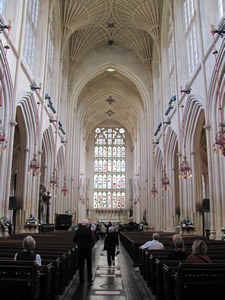
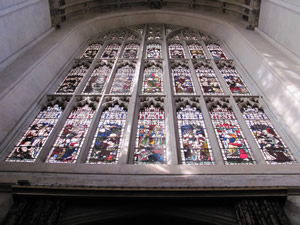
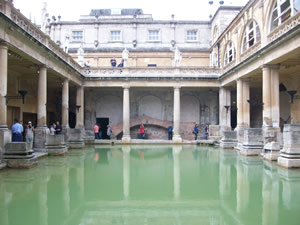 Our next stop was to the Roman Baths (www.romanbaths.co.uk), located adjacent to the abbey in the abbey green square. “According to legend, Bath owes its origin to the Celtic King Bladud who discovered the curative properties of its natural hot springs in 860BC. Cast out from his kingdom as a leper, Bladud cured himself by imitating his swine and rolling in the hot mud at Bath. In the first century, the Romans built baths around the spring, and a temple dedicated to the goddess Sulis Minerva, who combined the attributes of the Celt warrior goddess Sulis and the Roman goddess Minerva. Among the Roman relics is a bronze head of the goddess. Medieval monks of Bath Abbey also exploited the springs properties, but it was when Queen Anne visited in 1702-3 that Bath reached its zenith as a fashionable watering place. Our next stop was to the Roman Baths (www.romanbaths.co.uk), located adjacent to the abbey in the abbey green square. “According to legend, Bath owes its origin to the Celtic King Bladud who discovered the curative properties of its natural hot springs in 860BC. Cast out from his kingdom as a leper, Bladud cured himself by imitating his swine and rolling in the hot mud at Bath. In the first century, the Romans built baths around the spring, and a temple dedicated to the goddess Sulis Minerva, who combined the attributes of the Celt warrior goddess Sulis and the Roman goddess Minerva. Among the Roman relics is a bronze head of the goddess. Medieval monks of Bath Abbey also exploited the springs properties, but it was when Queen Anne visited in 1702-3 that Bath reached its zenith as a fashionable watering place.
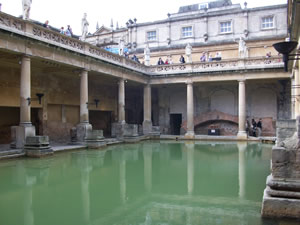 The open-air Great Bath, which stands at the heart of the Roman spa complex, was not discovered until the 1870s. Leading off this magnificent pool were various bathing chambers which became increasingly sophisticated over the four centuries the Romans were here. The baths fell into ruin, but extensive excavations have revealed the remarkable skill of Roman engineering.” This site is well worth a visit, even for those with little interest in history. The open-air Great Bath, which stands at the heart of the Roman spa complex, was not discovered until the 1870s. Leading off this magnificent pool were various bathing chambers which became increasingly sophisticated over the four centuries the Romans were here. The baths fell into ruin, but extensive excavations have revealed the remarkable skill of Roman engineering.” This site is well worth a visit, even for those with little interest in history.
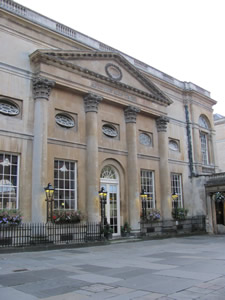 The Pump Room, attached to the Roman Baths, is a ritzy Georgian hall where visitors can sip tea, or a glass of the “curative,” but not so tasty, spa water, in the manner they’ve done for centuries. The Pump Room, attached to the Roman Baths, is a ritzy Georgian hall where visitors can sip tea, or a glass of the “curative,” but not so tasty, spa water, in the manner they’ve done for centuries.
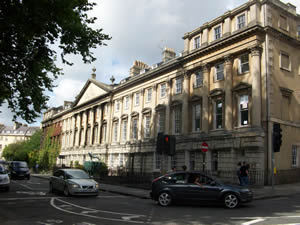 Walking across town, we strolled past the Theatre Royal, Queen’s Square, up Gay Street, where Jane Austen once lived at number 25, to the Royal Victoria Gardens. We then stopped for a look at the Royal Crescent. The crescent was built by John Wood (the Elder and Younger) and shaped into Georgian townhouses. A “ha ha fence” was built in the front yard, a sort of drop-off that acts as a barrier to keep sheep and peasants out, which is invisible from the windows of the homes. The refined and stylish Royal Crescent Hotel sits unmarked in the center of the crescent. You’re welcome to politely drop in to explore its fine ground-floor public spaces and back garden. Walking across town, we strolled past the Theatre Royal, Queen’s Square, up Gay Street, where Jane Austen once lived at number 25, to the Royal Victoria Gardens. We then stopped for a look at the Royal Crescent. The crescent was built by John Wood (the Elder and Younger) and shaped into Georgian townhouses. A “ha ha fence” was built in the front yard, a sort of drop-off that acts as a barrier to keep sheep and peasants out, which is invisible from the windows of the homes. The refined and stylish Royal Crescent Hotel sits unmarked in the center of the crescent. You’re welcome to politely drop in to explore its fine ground-floor public spaces and back garden.
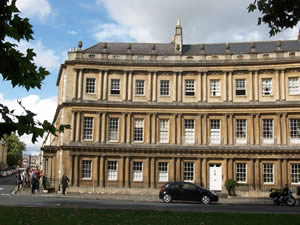 We then stopped off at the round Circus, which is best described as a coliseum turned inside out. Doric, Ionic and Corinthian columns decorate this homage to the Greco-Roman origins of Bath. Fashionable Georgians lived in these homes, and, indeed, to this day it is still part of the “high-rent” district. The first floors were built high off the ground to accommodate for aristocrats in sedan chairs and ladies in tall hairdos. A green area dominated by tall trees stands in the middle of the Circus where the old well once stood. Servants gathered to gossip here as they fetched water. If you stand in the center on top of the capped well and clap you can here it echo around the circle three times. I tried, and it works. We then stopped off at the round Circus, which is best described as a coliseum turned inside out. Doric, Ionic and Corinthian columns decorate this homage to the Greco-Roman origins of Bath. Fashionable Georgians lived in these homes, and, indeed, to this day it is still part of the “high-rent” district. The first floors were built high off the ground to accommodate for aristocrats in sedan chairs and ladies in tall hairdos. A green area dominated by tall trees stands in the middle of the Circus where the old well once stood. Servants gathered to gossip here as they fetched water. If you stand in the center on top of the capped well and clap you can here it echo around the circle three times. I tried, and it works.
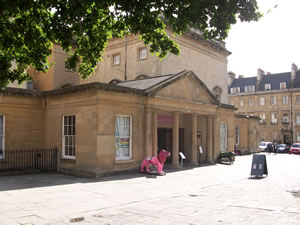 Nearby, stands the Assembly Rooms, whose basement is now home to the Museum of Costume, or Fashion Museum. I was excited to see these elegant Georgian ballrooms where the elite once strolled and danced, as they do in Miss Austen’s novels. In accordance with the style, the lower walls and floors are very plain, so as not to compete with the elaborate dresses and hairstyles of the ladies, but the upper walls and ceilings are extremely ornate. The Assembly Rooms were bombed during WWII, but they have been restored to their former splendor. The chandeliers are actually the only things original. The Fashion Museum, though much anticipated, was a great disappointment to me. They had very few historical costumes, and only from a select eras. The museum housed far more late 20th/early 21st century fashions and a huge exhibit on Princess Diana’s outfits. Nearby, stands the Assembly Rooms, whose basement is now home to the Museum of Costume, or Fashion Museum. I was excited to see these elegant Georgian ballrooms where the elite once strolled and danced, as they do in Miss Austen’s novels. In accordance with the style, the lower walls and floors are very plain, so as not to compete with the elaborate dresses and hairstyles of the ladies, but the upper walls and ceilings are extremely ornate. The Assembly Rooms were bombed during WWII, but they have been restored to their former splendor. The chandeliers are actually the only things original. The Fashion Museum, though much anticipated, was a great disappointment to me. They had very few historical costumes, and only from a select eras. The museum housed far more late 20th/early 21st century fashions and a huge exhibit on Princess Diana’s outfits.
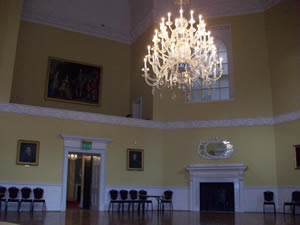 Strolling back down town along the river, we made one last stop at the Pulteney Bridge, built between 1769-74. This bridge over the Avon is strewn with shops. A relaxing riverside Parade Garden stretches along the banks of the river below, best enjoyed on a sunny day. Strolling back down town along the river, we made one last stop at the Pulteney Bridge, built between 1769-74. This bridge over the Avon is strewn with shops. A relaxing riverside Parade Garden stretches along the banks of the river below, best enjoyed on a sunny day. On our way out of town, we stopped to grab a late lunch at the Pasty Presto, where I tried my first traditional Cornish Pasty. They were homey and absolutely delicious, like beef stew wrapped in a crispy, flaky pastry shell. The double chocolate muffin was also divine.
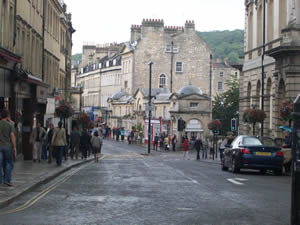
|